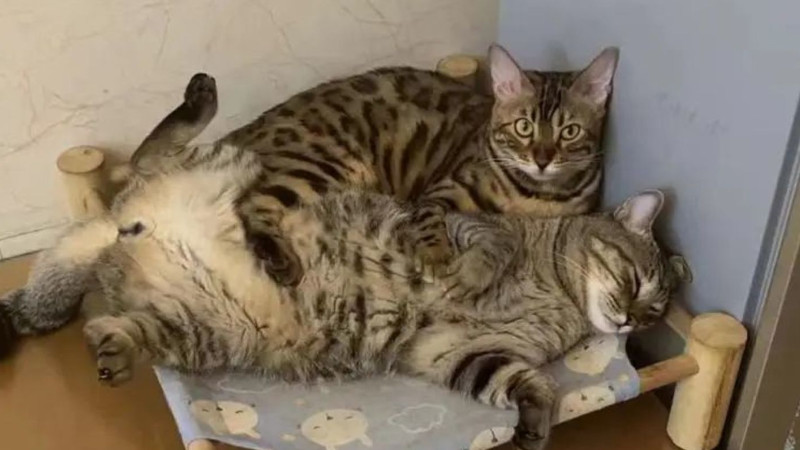No matter how much you love your cat, there are certain things you don’t want it to do. For me, one of those things is jumping up on counters.
My reason for disliking this behavior? There are several, all related to pet safety or human hygiene. Counters can be dangerous places. Kitchen knives might be left on them, and pet-toxic food could be accidentally out. I don’t want my cat to accidentally jump on a knife or eat unsafe human food when I’m not home.
Now let’s explore the possible motivations behind this behavior.
Option 1: Because food is involved. If your cat jumps onto the counter while you’re cooking or eating, it’s clear she wants the food. If this is the only time your cat jumps on counters, the solution is simple. Pull out a chair for your cat while you’re cooking or eating and give her kibble or cat-safe human foods only when she’s seated in this dedicated spot, not on the kitchen counter. Option 2: Because it’s a nice high spot to hang out in. Cats love jumping and take advantage of their ability to jump high. Even if you have a large house, having high spots for your cat is important. If you live in a small space, maximizing vertical space is crucial. This could mean getting a large cat jungle gym or a narrow cat tree. Rearranging furniture can also create high spots for your cat. Option 3: Because there’s a nice open window nearby. If your cat jumps on the counter and then sits by an open window, she’s after the window, not the counter. Open another window or get a cushy window seat for your cat. Option 4: Because the sink is a nice place to lick fresh water droplets out of. If your cat sits in the sink, it’s probably for the water droplets.Cats are selective about their drinking water, often preferring flowing water sources like sinks. Many pet owners struggle to ensure their cats drink enough water. If you’ve found your cat in a sink, you’ve discovered her preferred method of hydration. Solution: Find a replacement for the kitchen sink. You can turn on the tap slightly for your cat to lick droplets from the bathroom sink, a bathtub, or a shower. Providing an alternative, human-approved location for drinking water can help keep your cat off the counters.
If using a washroom sink or tub isn’t feasible, consider a cat fountain as an alternative. While it’s not the same as fresh tap water, many cats accept it, especially those picky about water sources.
Sometimes, your cat may jump on counters simply to get your attention. If you suspect this is the case, provide an alternative space for her to jump onto, like a chair, and give her the attention she seeks when she uses it.
Part II: Training Your Cat to Stop Going Up on Counters
Let’s delve into the training process, which is straightforward and based on common sense. Step 1: Have one or more alternate cat-approved spaces ready. Once you’ve identified why your cat jumps onto counters, prepare an alternative space to redirect her behavior. For cats jumping for food, have a chair next to the counter ready. For those seeking water, prepare a bathtub.
Step 2: Whenever your cat jumps up on the counter, say “no!” immediately and assertively, to communicate that the behavior is not allowed.
Step 3: Immediately pick up your cat and relocate her to the approved alternate space. This will help her associate the new spot with her desires, whether it’s attention or food, without being on the counter.
Step 4: Give your cat what she wants in the approved space. If she wanted attention, cuddle her there. If she wanted food, provide a small amount in the designated space.
Is your cat drawn to the droplets of water from a slightly open tap? This could be their preferred way to drink.
Step 5: If your cat re-offends by jumping on the counter, repeat steps 2-4 consistently. Every time your cat leaps onto the counters, say “no,” relocate your cat to an approved spot, and provide what she desires. It may take several repetitions for your cat to understand. If the training doesn’t seem effective, consider whether there’s another reason your cat enjoys being on counters. Step 6: Reward your cat immediately if they choose the alternate space on their own. Use whatever your cat was seeking from the counters—food, attention, water, etc.—to reinforce their presence in the designated cat-friendly areas. If your cat is on the counter for a high vantage point, spoil them with treats, cuddles, catnip, or play to thank them for behaving. Use the rewards your cat likes best to keep the approved spot in their mind as a happy one. Part III: Preventing Relapse You might think relapse will complicate things, but re-training a cat is easier than starting from scratch. Repeat the training process a few times to get back on track. For preventative measures, consider these actions to avoid relapse: Keep counters clear of food to reduce temptation; always have a chair ready for your cat during meal times; immediately correct any counter-jumping; and consistently reward good behavior, even after the undesired behavior has stopped. That’s it! If you follow through, you’re almost guaranteed to have a well-trained cat. Your Experiences With Cats on Counters? Do you have specific places you prefer cats not to be? Have you trained a cat to avoid certain spots? Why or why not? If you’ve successfully trained your cats to stay off counters, how long did it take? Have they ever relapsed? If you’ve tried and failed, would you attempt it again? Share your experiences in the comments below!

